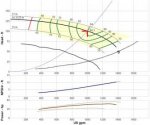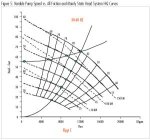ptonsparky
Tom
- Occupation
- EC - retired
Customer with a 100 HP motor pumping from a large tank to two pressure regulating valves. Input pressure to the valves is 96 PSI. Output is 53 PSI on the load side of one of the valves. Assuming for the moment that they are both set the same.
The only restriction on the inlet side is the short pipe connecting the centrifugal pump to the tank.
The VFD savings calculator I found indicated payback was in less than 2 months by just changing the speed(s) for x amount of time for each. That would be a quick sell.
Seems to me that I would also need to know how much water is actually moving at that 53 PSI in the 6"? pipes leaving the PR valves. What other values do I need to make a better SEWAssumptiveG in cost savings for a customer?
The only restriction on the inlet side is the short pipe connecting the centrifugal pump to the tank.
The VFD savings calculator I found indicated payback was in less than 2 months by just changing the speed(s) for x amount of time for each. That would be a quick sell.
Seems to me that I would also need to know how much water is actually moving at that 53 PSI in the 6"? pipes leaving the PR valves. What other values do I need to make a better SEWAssumptiveG in cost savings for a customer?



